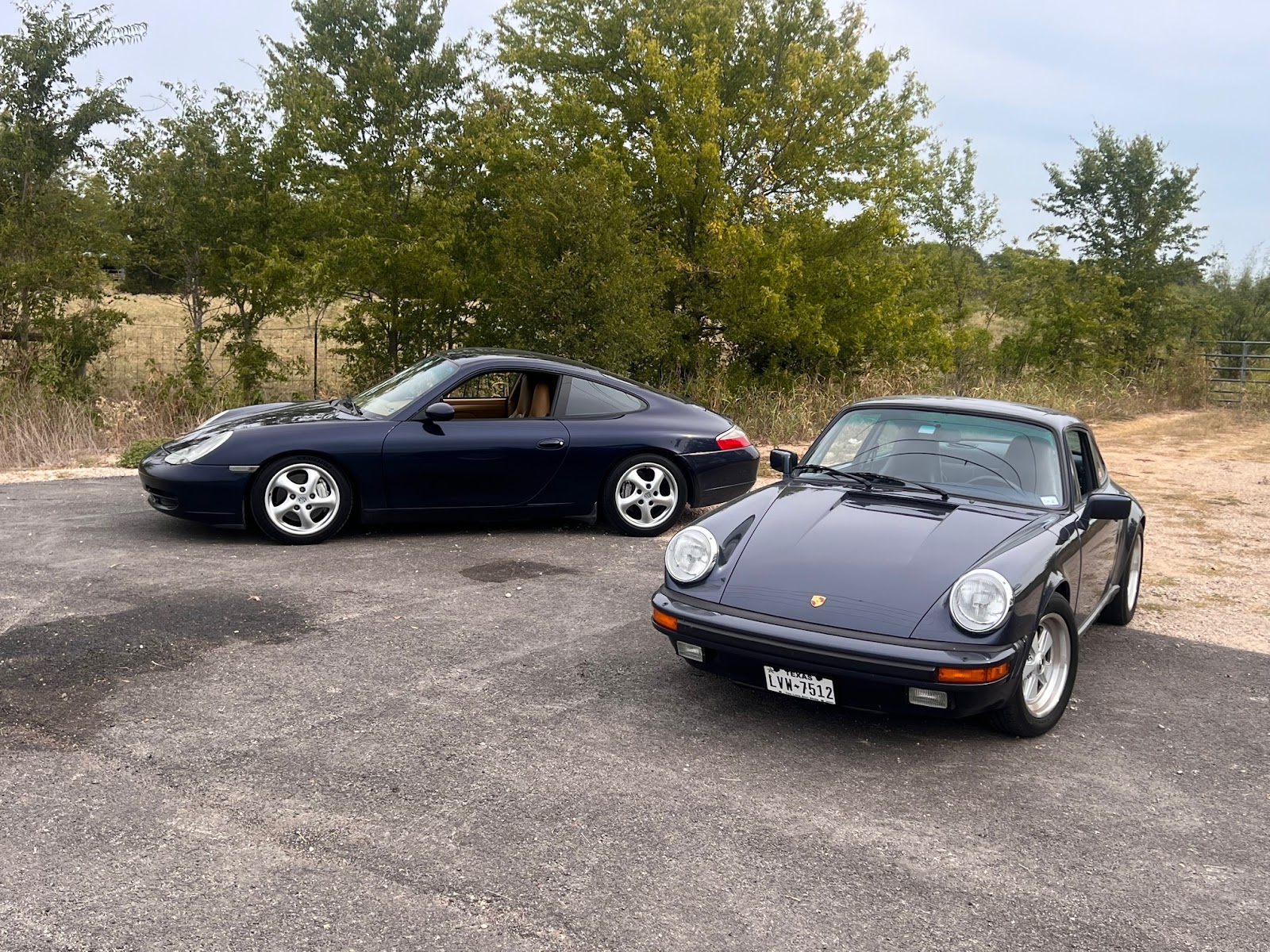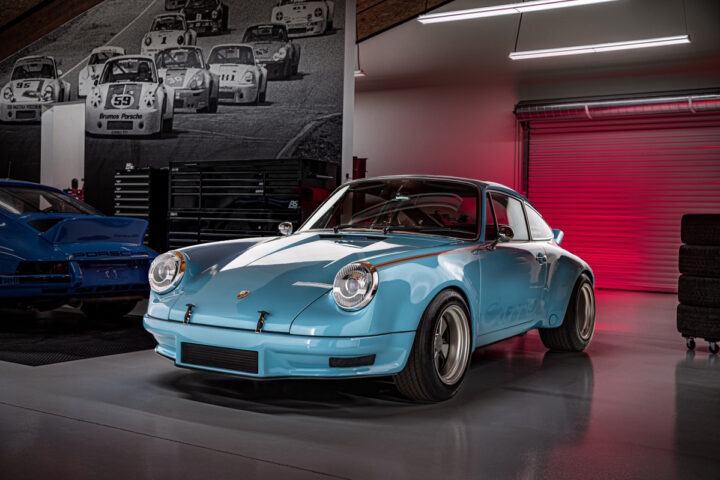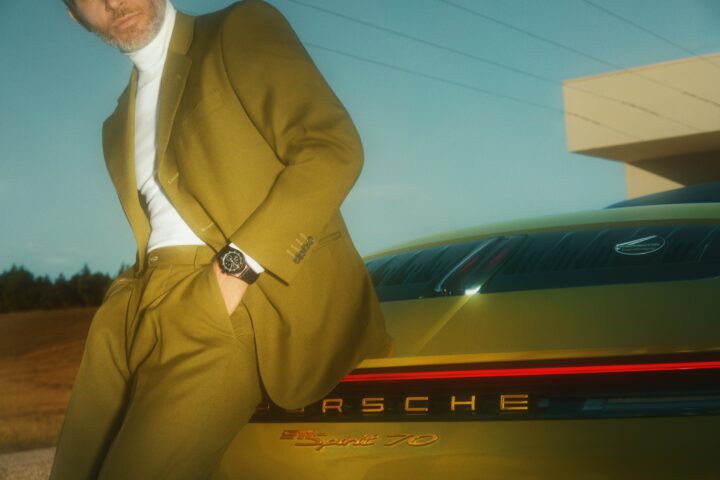by Rami Cerone and Blake Jennings
For those who love to drive, few cars offer more thrills on tight roads than a Porsche 911. While new examples cost more than most of us can afford, older models in reliable condition can be had for less than the average out-the-door cost of a new SUV. The question is: if you have $50,000 to spend on a 911, should you go old-school air-cooled or new-school water-cooled? A sixty-degree morning and empty country roads north of Houston gave us the chance to explore this question in matching blue 911’s from each era.
Representing the luftgekühlt era is Blake’s 1985 911 Carrera 3.2 in Prussian Blue with approximately 130,000 miles. This mostly stock example benefits from upgraded torsion bars, modern-ish air-conditioning, 993-era seats, cat-less sport exhaust, Porsche’s short shift kit, and grippier tires than originally specced. Representing the modern era is Rami’s 80,000-mile 2001 Carrera 4, meaning all-time, all-wheel drive. This Midnight Blue Metallic 996 generation 911 has a short-shift kit from a 997, is lowered, and rides on Michelin Super Sport rubber.
Let’s start with an important caveat. These cars both fit our $50,000 ceiling but are not equal in price. Blake bought his ‘85 three years ago in the mid-30s, and it has since risen in value to our ceiling. In contrast, Rami picked up his 996 last month in the low-20s, an absolute bargain, especially for a car with an IMS retrofit and significant preventative maintenance. So yes, both are “affordable” based on average new vehicle prices… but you can have two of Rami’s for one of Blake’s at current prices.
Now that the details are out of the way, let’s get to driving impressions! We took the cars out on our favorite back roads which vary from tight 2nd gear corners to fast 4th-gear sweepers and include a range of road types, elevation changes, and tarmac surfaces. After an hour, we swapped keys and tried the same roads again.
Impressions of a 996 Carrera 4:
Rami: This is a solid car and it feels substantial. The seats are narrow but supportive. The unmistakable sound of a rear-engine Porsche greets you as soon as you turn the key, which is still on the left side of the steering wheel in homage to early Porsche race cars. Visibility is excellent and the clutch is smooth. Power is linear, the torque is noticeable, and the car likes to rev high into its powerband. There is a slight notchiness to the gears, but it is very manageable and takes just a few minutes to become second nature. That said, quick shifts will not be a norm with this car. Once into the corners, the car sticks to the road with zero drama. This particular 996 has been lowered and has thicker sway bars, resulting in very little body roll. The car goes precisely where it is pointed, and the steering wheel provides lots of information about what the front tires are encountering on the road. This is truly a delight to drive, whether it is driven gently or enthusiastically. It does exactly what it’s asked, and feels light and agile while doing it. Once out of the corners and back on the highway, with the windows up and air conditioning blowing, it feels like a grand tourer. The miles flow effortlessly. Wind and road noise are low and the car is planted. Set cruise control and drive hours in comfort, as proven when I drove this car 450 miles back from New Orleans last month.
Blake: My first impression setting out in this particular 996 is that I cannot believe Rami got this car for this price! I expected squeaks and rattles and a sagging headliner. Instead, I found a clean, taught interior where all the buttons and controls still worked. And more impressive, the suspension and driveline felt factory tight, with the exception of excessive play in the gear shift mechanism that can likely be fixed with a couple bushings or cables. Getting out of my ‘85 and into this reminded me how so many people lost the forest for the trees with the 996. Yes, the headlights and interior switchgear still look ungainly in my opinion. But what are those nitpicks in comparison to a twenty-year-old chassis that can still offer such poise and speed on twisty roads at a price that rivals a used Camry!?
Now for details. The steering feel is superb and is benefited in this car by the addition of an aftermarket Momo wheel spaced further towards the driver. The hydraulic steering provides substantial feedback and proper weight for a sports car, though it is not quite as delightful as the non-assisted steering in my ‘85 (but parking lot maneuvers are much easier!) While the aforementioned shifter linkage needs repair, the transmission itself is tight and heel-toe shifting is phenomenally easy, especially in comparison to the 915 box in my ‘85. I actually second-guessed myself on my first 3-2 corner-entry downshifts, sure I must still be in neutral because it was simply too easy to rev-match and slide down a gear. The engine is equally good, providing strong torque from midrange and begging you to ring it out. For those used to modern low-lag turbos, this will not have the low-end grunt you expect. You must let the engine breathe and then shift to keep the revs above 3000. These engines do have the potential for catastrophic IMS failures, but this liability can be solved, as it was in this car, which leaves you with a superb and reasonably dependable engine. My only disappointment is that with a stock exhaust, it’s far too quiet for my taste. On the inside, seating is surprisingly tight. This car is larger than my ‘85 but feels noticeably smaller on the inside. That is largely due to the aerodynamic redesign that Porsche implemented with this generation, significantly increasing windshield rake. The effect is that this cabin feels more cave-like than older 911’s. On the upside, wind noise is down and top speed is up. Furthermore, the tighter cabin does mean that every control is within easy reach. The seats and pedals are perfectly positioned and supportive. This is a great place to sit while taking corners fast!
Impressions of an 80’s Carrera
Rami: Interestingly, this cockpit instantly felt roomier than the 996. The steering wheel is big and the view of the road is commanding due to the small dash and the very thin pillars. Starting the car sounds throaty as this example has an aftermarket exhaust and no catalytic converter. The sound is unmistakable. The clutch pedal is hinged to the ground which feels different the first time your foot presses it, but you adjust quickly and then never notice it again. The shifter is what feels most different from the 996. This is definitely not a fast shifter. It takes effort to put in gear, every gear, every time. Slow shifting makes it more work, but also makes the drive rewarding when you get it right. Acceleration feels great. While not as fast as the 996, it feels fast enough with plenty of torque. The corners are great in this car. There’s little body roll and it sticks to the road with unmatched steering feel thanks to its lack of power assist. The ride is firm but very comfortable and it tracks straight and feels solid. Downshifting for corners takes practice and sometimes requires a double clutch press. But this is part of the charm of an older 911. Windows down with the sound of the motor in your ears makes for a very engaging drive.
Blake: My first impression whenever I get into this car is how surprisingly airy the interior feels. This is a small car – the wheelbase is shorter than a Miata. I can reach both doors handles easily from the driver’s seat. Yet thanks to the relatively upright windshield that’s positioned close to the driver, along with thin A and B pillars, it feels bright and roomy with excellent visibility in all directions. The second impression comes with a turn of the key. The growl this engine makes is, in my opinion, among the best sounds in automotive history. The lack of water jackets on the cylinders combined with a catless sport exhaust provide enough sound to wake the neighbors. The third impression hits your nose ten seconds after startup: the smell of burning oil.
Like most 911’s of this era, the valve guides wear out and allow oil to seep into the cylinders when the car sits. That oil burns off in the first few minutes of driving. I need to fix that, but rebuilds on these engines run in the five figures, a distinct disadvantage to the ownership experience. My fourth impression as I set off, this transmission takes WORK, as Rami pointed out. For the uninitiated, 911’s used a very old transmission design called the 915 until the 1987 model year when it was replaced by the much more modern, but heavier G50. The 915 has long throws, weak synchros, and no centering spring. While mine benefits from the factory short-shift kit and an aftermarket centering and gate system, it is still very challenging to get into gear. Reverse is non-synchro, so you have to take it very slowly. After 130,000 miles, the 2nd through 4th gear synchros have worn, meaning these shifts take precise rev-matching and gentle engagement. Get it wrong and it makes a god-awful racket. Get it right, especially on a high rpm 3-2 downshift into a tight corner and you feel like Aryton Senna. That is the best way I know how to describe this car. It will not tolerate distracted or lazy driving. You must concentrate and work to drive it well. But when you get it right, it’s as if the stars aligned.
Back to our country roads. If you compare this car, and to a lesser extent Rami’s 996, to a modern sports car, one of the primary things you’ll notice is the substantial compliance over rough pavement. This car has relatively large sidewall tires over small diameter wheels, the opposite of sports cars today. Combine that with plenty of suspension travel, and it soaks up asphalt patches, bridge transitions, and camber changes in a way that few modern cars can. The steering also shines on these country roads. With no power assist and a large steering wheel, you can feel every undulation and change in grip. This is especially welcome given an old 911’s unusual weight-transfer dynamics. The engine is fully behind the back wheels, and you feel that far more in this 911 than in Rami’s all-wheel-drive 996. On a gravel strewn corner, his car stayed planted at speed while mine oversteered dramatically. Since I enjoy catching a slide, this was a bonus. But for those who prefer stability over drama, the 996 is a better fit. As for power, this car provides plenty of torque and a willingness to rev, but cannot match the pure speed of modern Porsches. This drivetrain is for those who prefer drama to outright power. Back out on the highway, this car easily kept pace with modern traffic and the 993 seats are among the most comfortable I have sat in. Air conditioning is the weak link in old 911’s, though this particular one benefits from substantial upgrades. While this car is not the effortless cruiser of Rami’s 996, it does not exhaust you or strand you on long trips like so many classic cars.
The verdict.
Rami: It was a perfect day and so much fun to drive these two cars back-to-back. Despite their differences, you can immediately tell one descends from the other thanks to their unmistakable shape. Our little convoy turned heads as the 911 is universally recognized and loved. Now to pick a winner. If I had to have just one car to drive every day, I would choose the 996. Comfortable, great air conditioning, easy clutch and shifter, and good sound insulation make it an easy daily driver that can go anywhere, yet still be fun when the roads get curvy. The air-cooled 911 feels special, but with its heavy shifting and old-school air conditioning, it would be too much for many on the daily commute. That said, you can’t exactly go wrong with either. People around the world praise 911’s of any generation, and drive them daily even with 100K, 200K, and more on the odometer. The 911 of any generation was made to be driven, not garaged. So just choose whichever one you personally find more fun to drive. They are also depreciation-proof. As long as you buy it right, paying attention to previous maintenance and condition, it is one of the few sports cars that you can drive without the fear of losing money with every passing mile.
Blake: On twisty backroads, you can’t lose no matter which of these cars you choose. I have driven many modern cars, some much faster than either of these. And yet none of them are as enjoyable on tight roads as these. Both are engaging and reward a driver’s skill without compromising comfort and reliability. Your choice will really come down to your personal preferences and needs. Note that neither are practical for a family. The back seats are seats in name only – my kids outgrew them by 10. So realistically, these are both two-seat sports cars. So what do you most value in a sports car? Speed or drama? Daily usability or occasion? Relaxed fun or intense concentration? If the former, the 996 is your match. If the latter, then like me you will be hard-pressed to find a more rewarding car to drive than an air-cooled 911.




















